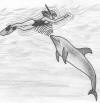1)
Hippotherapy & Therapeutic Horseback
Riding
2)
Dolphin-Assisted Therapy
HIPPOTHERAPY & THERAPEUTIC HORSEBACK RIDING
HIPPOTHERAPY: Derived from the Greek word “hippos,” meaning
horse, hippotherapy uses equine rhythmic movement to help individuals
with a variety of neurological disorders, including SCI. It is not
therapeutic horseback riding, which teaches riding skills to people with
disabilities. With hippotherapy, the patient doesn’t actively control
the horse, but rather is passively influenced neurophysiologically by
the horse’s movement while sitting on the animal. A therapist walks
beside the horse, staying close to the patient.
In addition to exerting positive psychological
influences, hippotherapy may be helpful for muscle tone, posture,
balance, and pain. Studies suggest it also reduces spasticity in
individuals with cerebral palsy, multiple sclerosis, and SCI. It is
theorized that the horse’s rhythmical movement promotes twisting and
stretching in the patient’s trunk, which, in turn, lessens spasticity.
SCI-focused studies include the following:
1) Dr. Helga Lechner et al (Switzerland)
evaluated the effects of hippotherapy on spasticity in 32 subjects with
SCI (1). Subject age ranged from 16 to 72 (average 37) years, all but
four were men, and the time from injury varied from one to 60 months
(most were injured less than a year). Injuries ranged from the cervical
C4 to the thoracic T12 levels and included both complete and incomplete
injuries.
On average each subject received 11 half-hour
hippotherapy sessions. Before and after each session, lower-extremity
spasticity was assessed using the Ashworth Scale. This scale measures
the resistance of a muscle being stretched with a five-point scale
ranging from 1 (no increase in tone) to 5 (limb rigid in flexion or
extension).
In hippotherapy sessions, subjects sat on a
sheepskin on a top of an Icelandic horse, a breed known for their
easy-to-handle nature. The horse was led at a walking pace by a skilled
equestrian with a nearby physical therapist to coordinate posture and
repositioning as necessary. A few subjects with higher-level injuries
required a second therapist sitting behind them for stabilization.
Of the 351 hippotherapy sessions carried out,
spasticity was reduced after 93% of them. The greatest reduction was
observed in subjects with high initial spasticity. No difference was
noted between subjects with paraplegia and tetraplegia. The reduction
was a relatively short-term effect that did not persist over time. The
investigators concluded that “hippotherapy is a valuable supplement to
the conventional physiotherapy approach in holistic rehabilitation of
SCIs.”
2) In 2007, Dr. Lechner and colleagues reported the
results of study comparing the effects of hippotherapy on spasticity and
mental well being with two other alternative therapies that mimicked
aspects of rhythmic horse movement (2). In the first alternative,
subjects sat astride a rubber-foam cylinder called a Bobath roll. Feet
were on the ground, and hands were resting on the thighs. In the second
alternative, subjects sat on a motor-driven rocking board integrated
into a wood stool with a cushioned seat. The rhythm of the side-to-side
rocking was adjusted to resemble the horse’s walking pace.
Eleven males were recruited with motor complete
injuries. Age ranged from 27 to 68 (average 44) years, and the time
since injury varied from 1.5 to 40 (average 13) years. Three subjects
had tetraplegia, and eight had paraplegia.
Subjects were divided into the three treatment
groups, i.e., hippotherapy, Bobath roll, and rocking board. After a
series of baseline evaluations, each group was treated with their
assigned intervention for four weeks. After a two-week break, the
therapy for each group was switched, and treatment was resumed for
another four weeks. Following this, there was another two-week break
followed by four weeks of the third treatment. For example, one group
would start with hippotherapy, have a break, resume treatment with a
Bobath roll, have a break, and finish with the rocking board. Spasticity
was assessed throughout the study. This sort of investigation in which
all subjects receive all interventions in the course of the study is
called a crossover study.
Of the three interventions, only hippotherapy
lessened spasticity significantly. As expected given the pleasure many
have from interacting with horses, only hippotherapy resulted in an
improvement of mental well being. The investigators concluded that
“hippotherapy reduces spasticity for a short time and temporarily
improves mental well being in persons with SCI.”
THERAPEUTIC HORSEBACK RIDING: In contrast to
hippotherapy’s passive involvement by the rider, therapeutic
horseback riding provide active training in horsemanship skills.
Ms. Glennys Asselin and colleagues (USA) studied the qualitative
effects accruing to a 46-year-old male with SCI after 13 weeks of such
training. This individual had become an incomplete quadriplegic due to a
motor vehicle accident 20-years earlier. During sessions, one
rehabilitation nurse led and another walked on the side of the horse.
The investigators believed that benefits are, in part, the result of 1)
the horse providing a three-dimensional movement which simulates the
gait of a human adult, and 2) the riding providing perpetual sensory
excitement through receptors in the joints, muscle, tendons, ocular
motor skins, and skin. The subject provided a number of positive
comments on his experience, including, “since riding my muscles have
woke up, and I can feel my legs more, using them to balance with, and I
can feel the horse move under me more.”

DOLPHIN-ASSISTED THERAPY
Dolphins appear to facilitate healing through
mechanisms not readily reconciled with modern medical precepts (3-4).
People frequently report that they become euphoric after swimming with
these loving, graceful, and joyous creatures. In turn, an uplifted
spirit seems to infuse beneficial healing effects into the mind and
body. Numerous people who have serious illnesses and depression have
reported dramatic, long-term, favorable changes in their emotional
state.
Scientists now know that these emotional changes
(which last much longer than the “high” experienced from the release of
endorphins, the body’s natural opiates) can initiate a cascade of
health-enhancing hormonal and physiological changes. Children with a
variety of developmental disabilities have shown remarkable improvements
after dolphin-assisted therapy. Learning, cognitive abilities,
concentration, communication, and ability to relate to others all
improve.
In addition to possessing a direct therapeutic
effect, dolphins appear to enhance other therapies. For example, the
Upledger Institute has treated individuals with a variety of disorders,
including SCI, with dolphin-assisted, craniosacral therapy (See Bodywork
Section). The therapy was completed in the water with, and in near
proximity to, the dolphins. Many beneficial effects were observed beyond
levels normally realized, including pain reduction, increased ease in
breathing, muscle relaxation, enhanced strength and flexibility,
increased appetite, and better sleep.
John, an individual with chronic paraplegia,
participated in this pilot program and recorded his experiences in a
journal:

“Dolphin Therapy this
morning, my Lord, what a morning! First we went for a "structured swim”
with two pregnant dolphins. The regular stuff, dorsal pulls, imitative
games, kisses, and pets. Then into a pool with a dolphin named Tina, a
young female, and a very strong girl. Tina would go to my feet and
blast energy up from there; it was completely powerful. Suddenly my feet
came alive with a pulsing energy. That pulsing energy went through my
body and into my lower spinal cord. Every time Tina would blast from my
feet, I would get a "therapeutic earthquake" from my first lumbar
vertebrae down into my sacrum. All my tissues in the lower part of my
body were literally shaking with energy. Talk about sending a shiver up
the spine, this was the ultimate.”
Next Day: “Starting at my
feet, there is a constant flow and movement of impulse, a indescribable
gyration of synergy that rotates and pulsates, ebbs and flows, buzzes
and beats, vibrates and harmonizes with a myriad of sensations that move
up and down my legs. This is more than I've felt down there since the
night I fell out of that tree. And the location is different too… this
morning, the energy web has moved all the way down into my feet and
pulsating upward from there. It is warm, I would say an almost glowing
awareness of my feet and legs, tissues and bone. It feels so fine.”
Although no one really knows how and to what degree
dolphins heal, a number of speculations have been put forth.
Scientists believe that the dolphin’s ultrasound
emissions have considerable healing potential from an energy and
informational perspective. Clinically, ultrasound has been used to
promote healing, for diagnostic imaging, and to destroy cataracts and
kidney and gallstones. Throughout history, sound - such as music,
drumming and chanting - has been used to promote health.
Physiologically, we now know that these sounds can influence heart rate,
breathing, muscle contractions, memory, and immune function. In terms of
energy, the dolphin’s ultrasound blast is four times stronger than
therapeutically used in hospitals.
Furthermore, this blast is delivered through water,
which is 60 times more efficient than air for sound transference, to a
body that is three-quarters fluid. It is believed that ultrasound
resonance within the cerebrospinal fluid is especially important due to
the fluid’s key influence on the brain and spinal cord.
Second, it has shown that human brain waves shift
from high-frequency beta to low-frequency theta waves after a dolphin
encounter. Beta waves are associated with increased concentration,
alertness, and enhanced memory function. In contrast, theta waves are
associated with enhanced creativity, sensory integration, and altered
states of consciousness. Scientists believe that a brain-wave shift of
this nature strengthens the human immune system. Furthermore, after a
dolphin encounter, research has shown a synchronization of brain-wave
activity between the logical, analytical left brain and the intuitive,
imaginative right brain. These brain-wave alterations may explain why
people view swimming with the dolphins as a transcendental experience.
These brain-wave alterations are facilitated by
sonar-induced cavitation. Basically, the dolphin’s intense sound waves
create alternating regions of compression and expansion that form small
bubbles in the cell membrane. In turn, these bubbles facilitate the
transport of key neurological molecules from outside to inside neurons.
Third, sci entists
also speculate that the dolphins’ therapeutic energy is mediated through
human energy fields (see discussion elsewhere). According to
speculation, dolphins can sense human-energy-field imbalances and adjust
their ultrasonic emanations. The dolphin’s powerful energy may initiate
an appropriate alteration in the human electromagnetic field, which, in
turn, will facilitate healing.
entists
also speculate that the dolphins’ therapeutic energy is mediated through
human energy fields (see discussion elsewhere). According to
speculation, dolphins can sense human-energy-field imbalances and adjust
their ultrasonic emanations. The dolphin’s powerful energy may initiate
an appropriate alteration in the human electromagnetic field, which, in
turn, will facilitate healing.
TOP